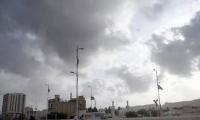MULTAN: Eight steel bridges set up at the Fort Munro, connecting the Iran-Pakistan border and Gwadar via N-70, have become fully functional for heavy traffic.
The National Highways Authority (NHA) officials said that the first phase of East-West improvement of N-70 from Rakhi Gaaj-Khar-Bewata had been completed with the Japanese financial assistance worth Rs 14 billion. The second phase was the construction of 55km dual carriageway from Rakhi Gaj to Dera Ghazi, they said, adding that the federal government had allocated funds for the project in the Public Sector Development Programme 2019/20. The NHA engineers and officials said that the architectural gem project had decreased vehicles’ operational and maintenance cost and travel hours between Punjab and Balochistan provinces.
They said that the steel bridges also added to the beauty of Fort Munro. They said that the area fell in the tribal region of Tuman Leghari.
NHA Director Construction Muhammad Sulait Ahmar said that the Japan’s most advanced technology was utilised in the steel bridges. He said: “This unique type of steel is not available in Pakistan. The technology includes box shaped girders made of maintenance free steel for more than 100 years and special embankment wall using light and strong material.”
The seven steel bridges were 11.5 kilometer long, connecting south Punjab to China-Pakistan Economic Corridor via N-70 from Bahawalpur to Multan, Dera Ghazi Khan, Fort Munro to Qila Saifullah to Gwadar and Iran-Pakistan border at Taftan, he said, adding that Muzaffargarh-Dera Ghazi Khan dual carriageway had already been completed and inaugurated by Prime Minister Imran Khan a couple of days ago.
He said that the then prime Minister Mian Nawaz Sharif had requested Japan for soft loan to establish the steel bridges. He said that the Fort Munro steel bridges project was executed in 2016 and Muzzafargarh-Dera Ghazi Khan dual-carriageway in 2017. The then Punjab chief minister Shahbaz Sharif had laid down the foundation stone of Muzaffargarh-Dera Ghazi Khan dual carriageway on October 14, 2017, he added.
He said that the hilly portion of Dera-Taftan Road from Rakhi Gaaj to high mountains of Girdo (Fort Munro) was constructed in the late 19th century by the British rulers as a part of the strategic forward policy in the subcontinent. Starting from Rakhi Gaaj-Khar-Bewata, the project made the hilly portion of the road wide and safe for Gwadar-bound cargo traffic, he added.
Embassy of Japan First Secretary Economic and Development Teruki Hanzawa said that the project site was traffic choke point with continuous steep, slopes and sharp curves. He said that Japan had provided concessional loan with the lowest markup rate of 0.2pc and the repayment period was 40 years with 10 years grace period. He said that Japan had provided $142 million to improve N-70. Teruki Hanzawa said that the physical work had been executed in 2016 and it was completed in the shortest period of three years with the help of Japanese and Pakistani engineers. He said: “A single track road has been expanded to double track and sharp curves with a radius of eight meters to 30 meters.”
Meanwhile, big trailers and trucks carrying heavy loads, passenger buses, vans and picnic lovers riding vehicles are found frequently moving on the route after the steel bridges gave a solution to the most dangerous and sharp curves in more than 6,000 feet high hilly area across Fort Munro. The Iranian cargo trucks are also entering the Punjab through Fort Munro steel bridges.
Meanwhile, the Japanese Embassy in Islamabad organised a tour of journalists from Multan to Fort Munro to examine Japan’s contributions towards Pakistan’s sustainable development.
Japanese Embassy First Secretary Economic Affairs Teruki Hanzawa, Japanese Consultant Naoka Kogure and others were also present.
PTI maintain leading position in NA elections, with narrow lead of one percentage point over PMLN
Nationalists say province's resources, land, and water were being sold under guise of development







